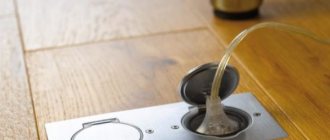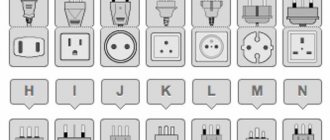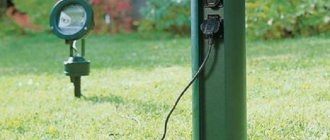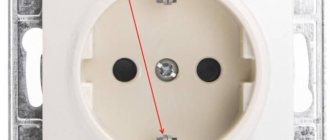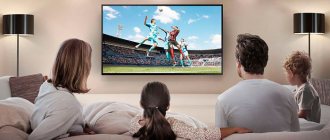Types of baseboard sockets
Today, my dear reader and I have to figure out how practical baseboard sockets are. We will weigh the pros and cons of the solution, find out when it can be used and when it is better to give preference to other methods of wiring electricity, and get acquainted with wiring installation technology. So, let's go.
What is a baseboard socket?
A socket on the baseboard is called a multibox, which is mounted directly to the wall border by inserting it into it or placing it in close proximity. An electrical installation element is used to increase power points in the house during renovations.
Externally, the electrical outlet is almost identical to the standard one. The only difference in the body of the device is that its lines exactly follow the bend of the baseboard in order to perfectly fit the socket into the curb.
Advantages and disadvantages
Plinth sockets have a number of positive aspects for the master:
- Using a multibox, you can place additional power points compactly and organically.
- Due to their low location relative to the floor, the sockets are not conspicuous, do not visually cut into a solid wall, and sometimes are completely hidden behind furniture.
- The rich color range of multiboxes gives the master the opportunity to choose the product exactly to match the color of the wall border. Types of baseboard sockets
- All wiring is securely hidden by the cable channel, does not lie on the floor and does not stretch along the walls.
- There is no risk of bumping into old cables in the wall when installing new ones - safety for the master.
- No dusty work.
- The ability to install an additional socket anywhere in the room without being bound to norms and standards when gating walls.
Baseboard sockets also have some disadvantages. These include:
- Moderate impact resistance. If there is frequent mechanical damage, the multibox may crack.
- Accessibility for children. In a house where there are children, it is better not to install such sockets or install them taking into account the placement of high furniture in order to block access to the power point.
- The negative impact of moisture on all wiring due to an accidental flood in the house or a bucket of water spilled directly on the outlet.
You can protect the power point from the baby or water using hard curtains.
Useful tips
Designs for a socket must have a deep box.
Keep in mind that the floor-mounted version of the socket is more convenient for installation, since it is used for many types of sockets.
These structures have a deep box, so there will be no problems with installation. For other types of electrical outlets, it is necessary to select a grounded outlet.
When using floor products, certain difficulties may arise. This way, dirt can accumulate around the structure, which can be quite difficult to get rid of later.
Also, you will not be able to place furniture close to the wall. Therefore, using a wall-mounted socket box is a more practical solution.
During work, be sure to follow safety rules. You will first need to turn off the voltage. The wiring should not be damaged, but exposed areas will need to be treated. For more information about installing floor plinths, watch this video:
Thus, with the help of a multibox, you can install an outlet in any part of the room, saving time and money on repairs. Thanks to the huge variety of skirting board designs, you can choose the option that suits your taste and suits the design of the room.
Specifications
To mount a socket in a baseboard, you should know its technical parameters:
- Dimensions - 55 x 22 mm or 70 x 22 mm.
- Voltage - 220-250 W.
- Number of phases – single-phase.
- Manufacturing material: plastic.
- Rated current - 16 A.
- Product type: single, double, triple.
There are floor and wall baseboard sockets. The first ones fit tightly to the wall border and the floor. The second ones grab the baseboard and the wall, but do not touch the base of the room.
Restrictions for installing sockets on baseboards
It is prohibited to install baseboard power points in the following cases:
- Laying wiring in wooden houses. Here, all cables are installed only in an open way, and sockets are used only overhead (external).
- The power point must be accessible at all times. Therefore, you should not install an outlet behind complex technical equipment (gas boilers, ovens, hobs, etc.).
The baseboard socket is installed only when the object is completely de-energized.
Conclusion
A socket for a baseboard is an almost irreplaceable device, which is difficult to do without when laying hidden wiring in plastic boxes. The variety of models of such sockets makes it easy to choose the option that is suitable both in appearance and functionality.
Well, the installation technology described above will help you install this element of the electrical network yourself. In the video presented in this article you will find additional information on this topic.
Installation principles
To carry out the work, the master will need:
- Perforator for forming holes for dowels.
- A hacksaw or grinder for cutting baseboards. The grinder makes a more even cut.
- A hammer equipped with a hammer.
- Tape measure/ruler and construction pencil.
- Side cutter for removing the braid from the cable.
- Screwdriver.
Also, to install hidden wiring, the master will have to prepare the following materials:
- Wall border (aka plinth), equipped with a cable channel. Its color and height can be arbitrary.
- End caps in the required quantity.
- Cable (three-core for grounding or two-wire - without it).
- Skirting socket (multibox).
It is advisable to take the cable and baseboard with a small margin.
Multibox
This is a special skirting board that has cutouts for the profile of the wall border. It fits tightly on it. There are different modifications of profiles on sale, so you can choose any multibox for any skirting board.
More often, the cover plate is used to install a regular socket. But it can accommodate outputs for telephone, Internet cables, etc. The multibox is installed as simply and quickly as possible.
Cable channel
Despite the fact that PVC skirting boards often already have a built-in channel, some craftsmen prefer to use separate plastic U-shaped boxes for cable laying. Externally, the channels vary in depth and height, which allows you to lay from 2 to 5 wires in them simultaneously. The top of the box is closed with a decorative lid. The cable channel is laid under the baseboard (except for wooden or frame houses).
Sockets internal and external
Built-in power points are mounted in a multibox, and external ones are used in tandem with a cable channel when laying wiring in wooden houses. If the internal power point can be used on any walls except wood, then there are no restrictions on the use of an external outlet.
Wiring layout
Accommodation Standards
So, we begin to lay out the wires around the room. What standards should we focus on when choosing the location of outlets?
In fact, there is no single standard for the placement of these elements, and most often they are installed in place of old socket boxes embedded in the walls of the house and permanent partitions.
But if you have a choice, it is still better to adhere to fairly simple recommendations:
When laying wiring hidden in the walls, sockets are mounted at a height of either 90 cm or 30 cm from the level of the floor covering
The first option is traditional for domestic construction, the second refers to the “European standard”. It is worth paying special attention to the sockets above the countertops. They should be installed in such a way that the table surface does not overlap the contacts and allows unhindered use of the device
The same applies to power points above the tables in the office and nursery. It would also be a good idea to provide wire output for connecting a computer or TV. Modern models of these devices are distinguished by a fairly high level of energy consumption, and therefore you should not hope that an ordinary “tee” will be enough.
It is most convenient to plug in floor-standing electrical appliances and stationary electronics into sockets in baseboards. Bottom placement allows you to significantly save space in the apartment and minimize the amount of work on gating walls for laying hidden cable channels.
Thus, we see that sources of electricity in an apartment can be located in a variety of places. Moreover, there is no single correct option, and the optimal choice would be a combination of points with high and low placement of sockets.
Why do we need sockets installed near the floor?
And yet, the subject of discussion in our article is the baseboard with sockets. In residential construction, this design has become widespread relatively recently, and therefore many do not take it into account when planning the power supply system for a house or apartment.
Note! In industry, sockets in baseboards are quite common. This is due to the fact that it is in industrial premises that electrical boxes are widely used, in which a large number of cables are placed
Installing a socket box on such a box is a completely obvious engineering solution.
Baseboard socket: standard industrial modification
As the name suggests, a socket in a baseboard is used when the wiring runs through a cable channel in a technical or decorative plastic box:
- Most often, this technology is used when expanding the electrical wiring network. If you are doing cosmetic repairs in an old house and do not want to open the walls, then new wires for household appliances, not provided for in the previous power supply diagram, should be laid this way.
- Also, laying wiring and placing installation boxes in baseboards is justified in a number of other cases. For example, if rearranging furniture leads to a situation where, to connect household appliances and electronics, it is necessary to pull the cable through almost the entire apartment.
Installation box option
It is worth mentioning separately about telephone and network cords: for them, building an outlet into the baseboard is almost the only acceptable solution.
Note! The last recommendation is especially relevant for dog breeders. If you don’t want to get pieces of cable “as a gift” when you come home, hide it in the baseboard and put it in a separate socket
Advantages and disadvantages of such a solution
Installing socket boxes on baseboards has a number of advantages:
- Firstly, as we noted above, it is possible to lay wiring in those corners of the apartment where it was not previously provided.
- Secondly, low placement makes the sockets almost invisible, and is therefore preferable from a design point of view. It should also be noted that modern industry produces baseboard socket boxes in a variety of shapes and colors, and therefore you can almost always choose an option that is in harmony with the style and color scheme of the room.
The appearance of the device is in harmony with the design of the room
Thirdly, with this installation, the connected wires do not hang along the wall, and this provides a significantly greater level of safety.
As for the disadvantages, the main one is the risk of liquid getting on the contacts during wet cleaning. The way out of the situation is to purchase and install models that are equipped with special protective curtains. Such curtains reliably cover the holes in the socket, and the risk of short circuiting is reduced to a minimum.
Features of installing baseboard sockets
There are a number of rules that should be followed when installing power points on a wall border:
- The plinth is fixed to a flat wall in increments of 0.5 m. If the panel has bends, the fastening spacing is reduced to eliminate the appearance of gaps between the curb and the wall.
- It is better to work with a hammer drill and install dowel-nails directly through the baseboard attached to the panel. This saves time.
- It is better to fill the cable channel with wires by 40%, but no more. Otherwise, overheating of the electrical wiring will occur.
- It is advisable to lay the cable freely, without tension. Sometimes, if the channel cross-section allows, even a small reserve is made.
- If the master installs ordinary overhead sockets close to the baseboard, a grinder is used to make a cutout right up to the box with the wires. This will make it easier to route the cable to the power point. And connecting the outlet to the curb will be neat.
It is better to carry out noisy work with a hammer drill on a weekday from 10:00 to 17:00 to minimize the level of discomfort for neighbors.
Materials
The plinth can be made of several materials. However, not all of them meet certain requirements and some may not be suitable for wiring.
Table. Types of skirting boards depending on the material.
| Material | Description |
| PVC or polyvinyl chloride | The most commonly used type of skirting boards, as it has many advantages. This material meets all fire safety requirements. PVC skirting boards are inexpensive, but at the same time they are durable, elastic and strong, and are not afraid of exposure to moisture and a number of chemicals. However, under strong mechanical stress, PVC skirting boards can easily break. There are also special skirting boards for laying high-voltage cables - they are made of a special type of PVC, which has maximum fire safety. |
| Tree | It is undesirable to use skirting boards made from this material as electrical equipment, since their fire hazard is quite high. However, wooden skirting boards are highly environmentally friendly. |
| MDF or fibreboard | Such skirting boards are usually solid and require fastening of cables using clips. According to manufacturers, MDF is a non-flammable material, but it still does not have the same fire safety ratings as PVC skirting boards. That is why it is recommended to use it only for laying communication wires. |
Veneered plinth
It is best to use PVC skirting boards for laying wires in an apartment or private house. They have a presentable appearance and are not prone to fire even if the wires are shorted.
Plastic floor plinth with cable duct
Installation of sockets
Depending on which power points will be used, the installation technique changes in some places.
Installation of baseboard sockets
To attach a baseboard with a cable channel to the wall, you need to do the work step by step in the following sequence:
- Remove the protective narrow cover covering the box from the top panel of the border. It is pryed off from the edge with a screwdriver.
- Apply the plinth to the wall and, in accordance with the markings (future location of the outlet), form an insert for the socket box.
- The plinth is secured with dowel nails to the wall.
- Install the multibox.
- Lay the cable and lead the wires to the outlet.
- All that remains is to connect them to the terminals.
Lastly, the top cover of the outlet, the decorative protective strip and the end caps are installed.
Mounting the power point on the wall
In this case, the wires are laid into the cable channels according to the instructions given above. But in the intended installation location of the socket, a small cutout is made on the back side of the baseboard to bring out the cable.
The overhead panel (multibox) is attached to the wall and wire strands are brought to its terminals.
All that remains is to fix the top decorative cover of the power point and place the plugs on the baseboard.
Cable channel on top of the baseboard
If you don’t want to lay the wires under the wall border or the wiring is installed in a wooden house, it’s better to just use a cable channel. The box is fixed parallel to the baseboard with dowel-nails. First, remove the top cover from the channel. After fixing the box, the wiring is laid in it and a protective panel is put on top.
The cable tails are connected to the wall socket.
Prefabricated structures
Almost all manufacturers of sockets and switches offer multi-case solutions made under one decorative panel.
How to install socket boxes in this case? If you install single boxes in a row, you can make a mistake of a few millimeters, and it will be impossible to secure a multi-place structure.
The stores offer various solutions:
- A socket box for double (or more) sockets in one volume. The advantage of this solution is that the seats for blocks of sockets or switches fit perfectly. After installing the socket box, you get a monolithic structure. The disadvantage is that when drilling holes in a concrete wall, more work is done - it is necessary to create an oval recess. In addition, if you install such a block in a thin partition (80–100 mm), you violate the strength of the wall.
- Stacked structures. We can say that this is a standard solution for electrical installation. Almost all single socket boxes can be assembled into “garlands” of any number of modules. The main thing is that all elements are from the same manufacturer and from the same series.
- The advantage is that you simply buy a batch of such boxes, and then complete either single or five modules. In addition, the holes in the wall do not require large-scale modifications: it is enough to cut out the passages for the wires with a jumper. There is a drawback, although it is not significant. It is necessary to strictly maintain the horizontal line of the set screws, otherwise it will be difficult to adjust long blocks.
The shape of the boxes is not of fundamental importance. Round socket boxes are easier to install, since the holes for them are drilled with a conventional drill with a crown. However, square-shaped socket boxes are also in demand. If the wall material allows you to cut a rectangular hole without extra costs, install these boxes. They make it easier to accommodate long wires.
In terms of installing sockets or switches, there will be no difficulties. Seats are standard for both round and square shapes.

